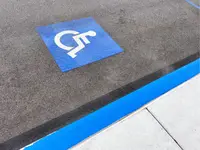The small towns, parishes and municipalities throughout Louisiana present unique challenges when it comes to ensuring accessible streets for all. To best serve all the members of a community, it is important to both understand and adhere to ADA compliance. However, the path towards making small towns, parishes and municipality infrastructure fully accessible can feel daunting, especially with limited budgets.
Understanding the Basics of ADA Compliance
Let’s start at the beginning with the Americans with Disabilities Act (ADA), enacted in 1990. Title II of the ADA particularly holds public entities responsible for providing accessibility in all programs, services, and activities. How this translates to small town infrastructure, includes making public streets and sidewalks accessible for all.
At a minimum, ADA compliance for small towns, parishes, and municipalities in Louisiana means:
- Installation of elements that facilitate access for individuals who use wheelchairs, walkers, or other mobility aids
- Unobstructed sidewalks and/or pathways of minimum width that cater to safe and easy passage
- Ensuring that pedestrian crossings are user-friendly and accessible for people of all abilities including those who are blind, deaf and hard of hearing
- Creating accessible parking spaces with adjacent access aisles to allow individuals with disabilities to transfer safely in and out of vehicles
Understanding the ADA and its implications on pedestrian crossing and street compliance may seem complex, but with a systematic approach to evaluating current infrastructure and mapping the necessary enhancements, it can be achieved. Remember, the underlying spirit of the ADA is about fostering inclusion and equal opportunities for all; this is what drives the journey towards compliance.
Assessing The Current Infrastructure
Before a small town or municipality embarks on an ADA compliance journey, a comprehensive evaluation of the existing infrastructure (typically conducted through site reconnaissance and field measurements) is critical. Assessing the compliance of existing infrastructure are typically driven by national design guidelines provided in the ADA Standards for Accessible Design and Accessibility Guidelines (ADAAG), Public Right-of-Way Accessibility Guidelines (PROWAG), and Manual on Uniform Traffic Control Devices (MUTCD). If this is alphabet soup is a bit overwhelming, don’t worry — lets breakdown exactly what those agencies are evaluating:
- Sidewalks
- Pedestrian crossings
- Public pathways
- Existing ramps
- Sidewalk surfaces
- Sidewalk widths
- Cross slope
- Current walk signals; timing and audio cues
- Parking lots
Having a clear understanding of the ADA design guidelines makes it easier to pinpoint locations where existing facilities, similar to the ones listed above, may be out of ADA compliance Making repairs to non-compliant facilities can sometimes impact other existing structures. Therefore, as part of the field assessment, items such as visible utilities, trees, furniture, posts, signs, kiosks, mailboxes, landscaping, and building facades are also identified.
The result of this thorough assessment will shed light on the level of accessibility and pinpoint high-priority areas that require immediate attention and improvement. This evaluation will help to create the northstar for what an ADA compliant infrastructure looks like.

